Financial Word of the Day: Market Sentiment
- Larry Jones

- Sep 8, 2025
- 2 min read
Updated: Sep 24, 2025

Definition of Market Sentiment
Market sentiment is the overall mood of investors about the market (or a specific stock, sector, or asset). Are people feeling optimistic (bullish), pessimistic (bearish), or just…meh (neutral)? That collective mood often shows up in prices, trading volume, and volatility.
Why It Matters (a lot)
Prices move on feelings just as much as on fundamentals.
Extreme sentiment can signal turning points (euphoria often precedes drops; doom often precedes rebounds).
Reading sentiment helps you choose when to buy, trim, or simply wait.
How to Spot Market Sentiment (quick reads)
Price and volume: Big up days with strong volume = bullish tone; repeated selloffs on heavy volume = bearish tone.
News and social chatter: Headlines and feeds either cheerlead or doom scroll. (Neither is gospel, both are signals.)
Surveys and indicators: AAII sentiment, CNN Fear & Greed Index, put/call ratios, VIX (fear gauge).
Flows: Money moving into/out of funds or sectors hints at crowd conviction.
Simple Conversation Example
“Tech rallied again, but the put/call ratio is low and the Fear & Greed Index is flashing ‘Greed.’ Market sentiment looks frothy—I’m rebalancing instead of chasing.”
Mini Case Study (30 seconds)
You’re eyeing a solid dividend stock trading at 10% below its 200-day average after a wave of gloomy headlines. Fundamentals haven’t changed much, but sentiment is sour. Instead of bailing, you:
Review earnings and cash flow (still fine).
Start a staged buy: 1/3 now, 1/3 if it dips 5% more, 1/3 after next earnings.You respect sentiment but don’t let it boss you around.
How to Use Sentiment Without Getting Played
Have rules. Pre-set buy/sell zones or a rebalancing schedule. Sentiment informs timing; rules prevent impulse.
Fade extremes. When everyone’s euphoric, trim winners; when panic spikes, build watchlist buys.
Pair with fundamentals. Sentiment is the weather; fundamentals are the climate. Trade the weather, invest for the climate.
Journal your emotions. Note when you feel greedy or fearful. If your gut matches the crowd, slow down.
Watch-Outs
Sentiment can stay irrational longer than you stay confident. Use position sizing.
Indicators conflict. Don’t bet the farm on a single signal.
Lag is real. By the time headlines scream “all clear,” much of the move may be over.
Related Terms
Bullish • Bearish • Momentum • Contrarian • Volatility (VIX) • Put/Call Ratio • Risk-On/Risk-Off
Try This Today (2-minute habit)
Check a broad sentiment gauge (e.g., Fear and Greed or AAII).
Look at your top 5 holdings. Are you tempted to chase? Or panic-sell?
Make one small, disciplined move (rebalance 1–2%, set a limit order, or do nothing…on purpose).
Bottom Line
Market sentiment is the crowd’s temperature. Smart investors don’t ignore it—but they also don’t let it run the portfolio. Use it to time how you act on well-researched ideas, not whether you have a plan. Keep your head when the crowd loses theirs, and you’ll buy more peace of mind along with your shares.






Comments